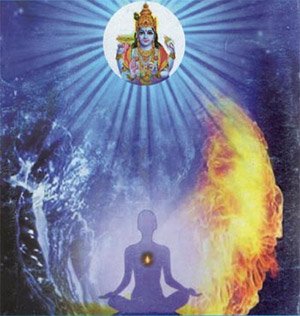Siddhanta Sangraha of Sri Sailacharya
by E. Sowmya Narayanan | 2008 | 30,562 words
Siddhanta Sangraha Chapter 3 (English translation), entitled “the sense organs” as included in the critical edition and study. The Siddhanta Samgraha is a Sanskrit philosophical text dealing with Vishishtadvaita in five hundred Sanskrit verses. It was written by Shri Shailacarya (18th century) and closely follows the philosophy of Vedanta Deshika (13th century).
Chapter 3 - The Sense Organs
16. It is because there is a specific injunction as “among the indriyas I remain as the mind”[1], the sense organs has the mind as their sixth one, and the eleventh sense organ is the mind.
17. Since the mind functions in the activities like resolve, remembrance etc., it is termed as the karaṇa.[2] There is no doubt that they are on par with the other sense organs like eye etc.,
18. The mind is denoted by various designations such as chitta etc., because of its capability of contemplating etc., which are its adjuncts. This is similar to Vāyu which attains various names such as prāṇa etc., because of the limiting adjuncts (Upādhi).
19. (Therefore) the mind is the cause for knowledge which can be established by positive and negative (anvaya-vyatireka) concomitance and by scriptural authority. Hence there can be no contradictions to this fact.
20. Those who know the true import of the Vedas declare that food nourishes the mind and that it is originated from the sātvikāhaṃkāra. Therefore it is non-eternal.[3]
21. The sense organ of hearing is the cause of sound perception and hence only it is known as śrotrendriya. It gets nourished by ether and hence become capable of its functions.[4]
22. The sense organs have external functions and the mind follows them. Thus there is the valid authority to this fact. The organ of hearing comprehends the external sound;
23. The sound perception that are in remote distance is comprehended by the śrotrendriya, as they are carried by Vāyu along with the subtle elements of the drum sound to its proximity or by the atom particles of the drum sound as the quality.
24. This is similar to the smelling of fragrance etc., by the ghrānendriya which are carried by the wind. If the wind blows in the opposite direction then the sound perception is not audible.
25. The theory that the sound originates simultaneously like the blossoming of the kadamba flowers is not to be accepted.[5] The organ of touch becomes the immediate cause for sense perception.
26. The Vāyu is only the nourisher to the sense organ of touch and it is not the product of Vāyu. The sense organ of Vision is the cause for the rūpa pratyakṣa.
27. Similarly, light becomes the nourisher of the sense organ of sight and as such it is not the product of light. The cakṣurindriya comprehends the form of the object through the rays that emanate from it.
28. All these views are acceptable, like the Vedāntins, to the followers of the Gautama school. The sense organ of Taste is nourished by the waters and it is not originated from waters. The view that the sense organ of taste originate from waters is postulated by others.
29. The ghrānendriya is the cause for the sense perception of smell. This sense organ of smell becomes capable of its functions being nourished by the particles of the earth (pārthivāṃsa)
Footnotes and references:
[1]:
See Bhagavad Gītā Ch. X, śloka 22
[2]:
“kāryaniyata pūrvavṛttiḥ karaṇam”—Tarka Saṅgraha, P.73.
[3]:
This is to criticisize the view of naiyāyikas, who content that the mind is eternal.—Tarka Saṅgraha. p.52
[4]:
The naiyāyikas contend that ether itself becomes the śrotrendriya. This view is criticized.—See Tarka Saṅgraha. p.67
[5]:
There are two theories in regard to the origination and the comprehension of sound perception, one is known as ‘vīcītaraṅganyāya’ (the wave theory) the ‘kadambamukula nyāya’ (the blossoming of flowers) wherein the sound spreads simultaneously in all directions. In the former the sound originates in a particular direction like the waves. The author seems to favour the former view only. See Tarka Saṅgraha Dīpikā, p.84
Conclusion:
 This concludes The Sense Organs according to Vishishtadvaita philosophy explained by Shri Shailacarya. This book follows the model of Vedanta Deshika although the Vishishta Advaita school was originally expounded by Shri Ramanuja. Vishishta-Advaita is one of the various sub-schools of Vedanta which itself represents one of the six orthodox schools of Hindu Philosophy. They highlight the importance of the Upanishads, the Bhagavad Gita and the Brahma Sutras.
This concludes The Sense Organs according to Vishishtadvaita philosophy explained by Shri Shailacarya. This book follows the model of Vedanta Deshika although the Vishishta Advaita school was originally expounded by Shri Ramanuja. Vishishta-Advaita is one of the various sub-schools of Vedanta which itself represents one of the six orthodox schools of Hindu Philosophy. They highlight the importance of the Upanishads, the Bhagavad Gita and the Brahma Sutras.
